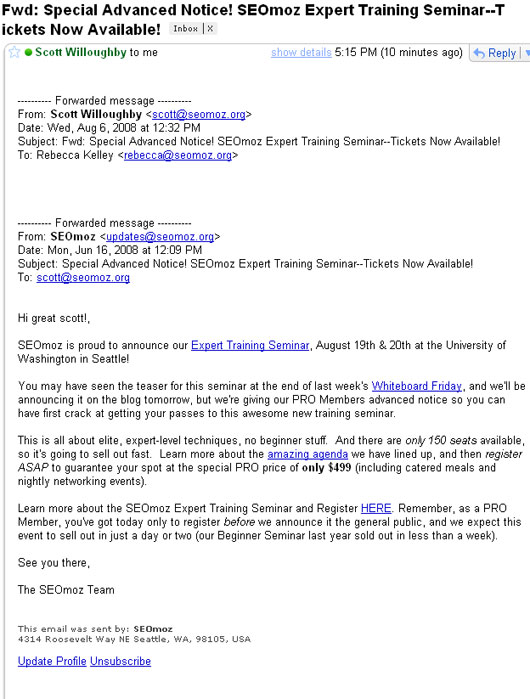
Learning a Little About Email Marketing
The author's views are entirely their own (excluding the unlikely event of hypnosis) and may not always reflect the views of Moz.
I don't know a whole lot about email marketing, but I enjoy studying the marketing emails I receive and identifying the ones that are more effective than others. I talked to Scott, who handles our email marketing campaigns, and he praises email marketing for being "dirt cheap and very effective." I can agree on the cheap part: we use Exact Target, whose suite of email marketing solutions start at $1,000 per year for one user and go up to an Enterprise account ($15,000 a year for five users). While there are expensive email marketing packages available, you can definitely find an affordable option to start out with and get your feet wet.
As for effective? Well, we haven't been doing email marketing for very long, but our average open rate is 27.4%, with an average CTR of 12.7%. Our conversions vary, but we were able to sell 200 video training DVDs within 4 days of announcing the product via an email marketing campaign to our members. Considering how low the cost per conversion is, the conversion rate was pretty good. Here's an example of one of our email marketing efforts:

- In 2008 thus far over 250 billion B2B spend has been driven/influenced by email in the US [Forrester]
- 80% of marketers say that email is the strongest performing media buy and that it has a higher ROI than search [Datran]
- 50% of marketers are emailing prospects as well as customers [Direct Magazine]
- 78% of marketers said this year they would significantly increase email marketing investment for customer acquisition [Marketing Sherpa]
- According to the Direct Magazine annual forecast survey, email has become the top medium choice for direct marketers. Of the firms polled for the survey, 72% said they send email to customers (a 10% increase over 2007), 50% send email to prospects (a 9% increase), and 55% of those who use email for marketing plan to increase their budgets for it.
Spam. Spam spam spam spam spam. Not only do many email service providers have constantly improving spam filters, but the CAN-SPAM Act outlines some requirements that commercial emailers must adhere to when crafting an email marketing campaign. For those of you who aren't aware of the CAN-SPAM Act, it was created to establish requirements for marketers who send commercial email and spells out penalties for spammers and companies who violate the law and advertise their products/services through spammy means. It also gives consumers the right to ask emailers to stop spamming them and requires these emailers to comply.
But you don't need to worry about violating the CAN-SPAM Act because you're not a filthy spammer, right? Well, in case you're wondering what the biggest no-no's are, there are essentially 4 main provisions:
- False/misleading header information is banned
- Deceptive subject lines are prohibited
- Your email must give recipients an opt-out method
- Your commercial email must be identified as an ad and must include a valid physical postal address
Okay, say you're being a good little marketer and are complying with the CAN-SPAM Act but are still having problems tripping recipients' spam filters. What should you do? Well, here are some things to avoid from both a spam filter and a user's perspective:
- Don't use Excessive Capitalization or punctuation!!! You don't want your emails to evoke the professionalism and trustworthiness of a used car lot or a furniture liquidation sale.
- Don't use (or limit the use of) SPAM filter catch words, like Free Viagra Sex Guaranteed with Credit Card! Though I must admit, that sounds like one hell of a deal...
- Don't use cluttered layouts. Even if your email passes the SPAM filter, cramming a bunch of content into an email is likely to overwhelm and confuse your recipient.
- Don't just send one big image. Sometimes they won't display at all (in Gmail I have to click "Display images below" on emails from unknown senders) or they can be slow to load. If you do use images in your emails, be sure to test the emails thoroughly before sending them to hundreds of recipients.
- Don't excessively use "Click Here," especially in ALL CAPITAL LETTERS. Obviously, you'll want a call to action in your email, but don't go too crazy with it.
- Don't send your emails from free mail services like AOL, Hotmail, and Yahoo. This especially rings true for B2B marketing. Nothing screams unprofessionalism like sending a marketing email from "[email protected]."
- Create a compelling/interesting subject line. This recommendation extends beyond email marketing to social media submissions, blog post titles, newspaper and magazine articles, etc., but it's a good golden rule to keep in mind.
- Test, test, test, and test again. It's better to test too much than too little, and the last thing you want to do is overlook something and send your message out to thousands of recipients, only to discover that your call to action points to the wrong URL.
- Think above the fold. As with newspapers and landing pages, you'll want to try and present your most compelling information in the top half of the email. If users have to scroll down to get to the good stuff, most of them won't see it.
- Have a specific call to action. Once again, this is a general best practice with landing pages. Be specific with your CTAs; instead of "Click Here," try "Start Referring Your Friends Now" (from a Vonage email I received), "Shop all Road ID Styles" (from Active.com), or "All Outerwear 20% Off! Shop Now" (from a clothing catalog). Test which variations garner higher click throughs, but always strive for a compelling call to action that will entice your reader to click on it.
- MindValley Labs email marketing category on their blog
- Email marketing best practices from EmailLabs
- Exact Target's eemail marketing blogs
- An email marketing tip sheet from Audette Media
- Delicious bookmark results for "email marketing tips"




Comments
Please keep your comments TAGFEE by following the community etiquette
Comments are closed. Got a burning question? Head to our Q&A section to start a new conversation.